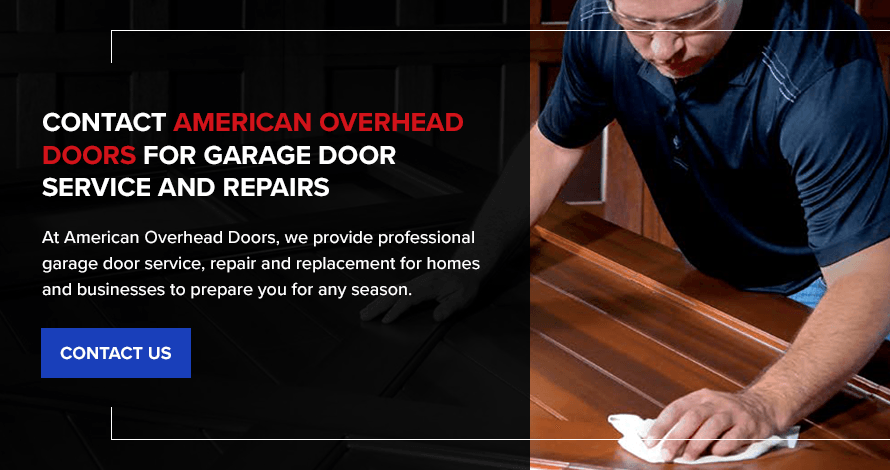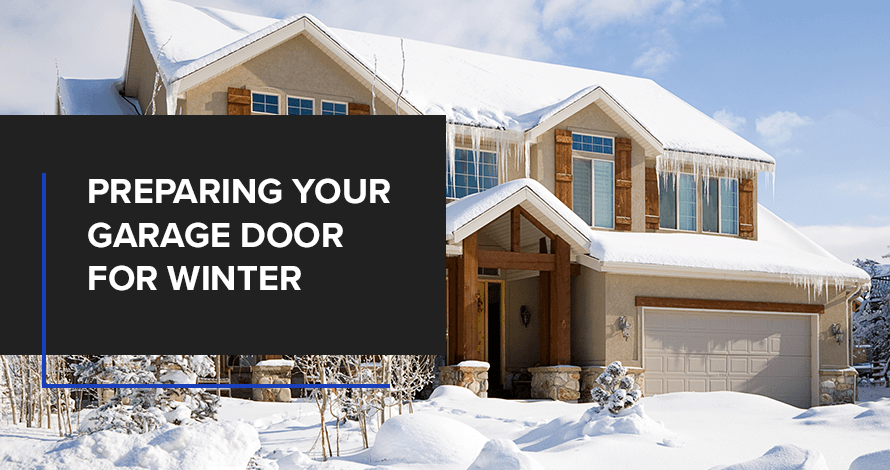
Your garage door is likely the largest functional appliance of your home or business. It withstands heavy use as you might open and close it thousands of times each year and multiple times a day. It’s exposed to the elements of each season, sustaining a great deal of wear and tear. The cold winter weather in a state like Connecticut can be unforgiving, so it’s important to prepare your garage for winter.
There are several precautions you can take before temperatures start to dip. Investing in these precautions can help prevent emergencies and reduce repair costs long term. Many precautions are quick and inexpensive, but have a significant impact. Learn how to seal your garage door for winter and discover other steps you can take below.
How Does Cold Weather Affect Garage Doors?
Extreme cold and exposure to snow, sleet and ice can have an adverse effect on any appliance or piece of machinery. Your garage door is not immune to these impacts. It has several elements that are sensitive to the effects of winter. Though garage doors can be many different materials, none can withstand winter without any preparation. Here are some common garage door issues in cold weather:
- Shrinking metal: Particles move slower and take up less space when chilled. As a result, the cold causes metal to contract. Pieces of hardware like springs and screws will shrink. When this happens, your door might not be able to open and close. Springs can snap, and the metal track can warp. Proper weatherstripping, insulation and lubricating oil can minimize the effects of contracting metal.
- Allowing cold in: A lack of proper insulation allows the cold to seep in, which can affect the temperature of your living or working space. This can drive up your energy bills and make your indoor space less comfortable. Insulation and weatherstripping also help solve this problem.
- Absorbing water: As snow and sleet fall, parts of your garage door might absorb water, causing swelling. The swelling might prohibit closing. If the absorbed water freezes, the door could freeze shut. Doors with wooden panels are the most susceptible to this issue, and protective treatments can prevent this from happening.
- Fogging sensors: The safety sensor on your garage door keeps it from closing if it perceives an obstacle in the way. Winter weather can cause the sensors to fog over, mimicking an obstacle. Piled up snow or ice near the bottom of the door can have the same effect.
- Getting stuck: Any of the above issues can cause your garage door to get “stuck” and be unable to open or close. Precautionary measures protect your garage and prevent the door from sticking.
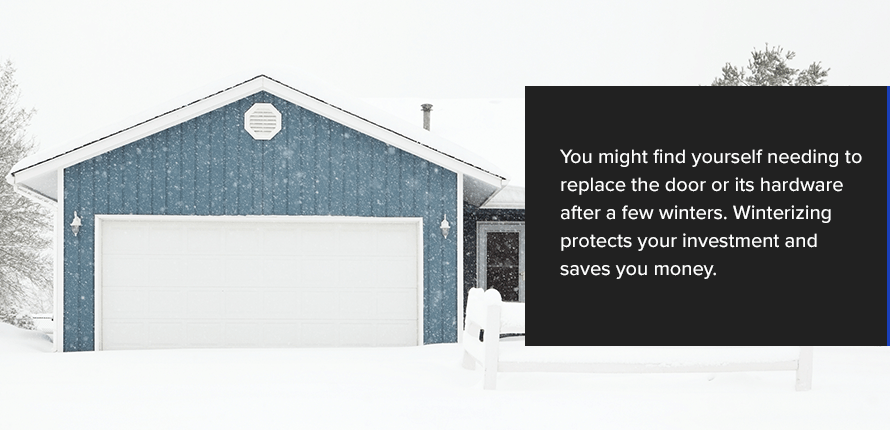
Why Winterize a Garage Door?
Preparing your garage for winter is vital to avoid ending up in an emergency situation with a door that refuses to move. A door stuck closed can be a serious dilemma — if your vehicle is trapped inside, you’ll have a hard time getting anywhere. If your vehicle is trapped outside, there’ll be nothing to protect it from the elements. And if your door is stuck open, everything in your garage will be exposed and you’ll have a tough time regulating the temperature. Even if your door functions without getting stuck, poor insulation can cause burst pipes and higher heating bills.
Winter weather will affect other elements of your garage in addition to the door. The cold can cause your pipes to freeze. The snow, ice and salt on your vehicle can erode your concrete floors. If shared walls are not well insulated, your heater will have to work harder, driving up your utility bills. An unprotected floor can also worsen insulation problems by creating cracks and gaps.
In addition to momentary inconvenience, the effects of winter can shorten the life span of your garage door. You might find yourself needing to replace the door or its hardware after a few winters. Winterizing protects your investment and saves you money.
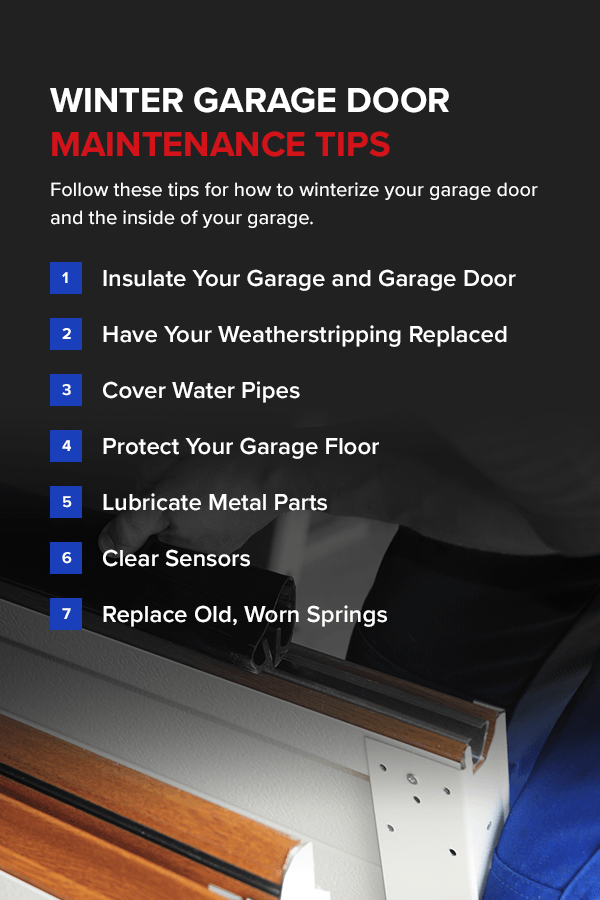
Winter Garage Door Maintenance Tips
As temperatures drop and the first snowfall looms, take some time to prepare your garage. Some tasks you can do on your own, while others may require professional service. You’ll find even the simplest preventive maintenance tasks can make a huge difference. Follow these tips for how to winterize your garage door and the inside of your garage.
1. Insulate Your Garage and Garage Door
It’s helpful to keep your garage warm during winter by installing proper insulation. You’ll find this has several benefits, including:
- It protects the internal hardware of your garage door.
- It protects the objects stored in your garage.
- It can lower your energy bills and improve the efficiency of your heating.
- It makes your garage a more livable, usable space during winter.
Many garages share at least one wall with a home or building, so proper insulation has a significant impact on indoor temperature regulation. At the least, you’ll want to improve the insulation of the shared wall to create a temperature barrier. If you’re thinking about upgrading or replacing your garage door, consider a well-insulated material. For instance, a four-layer garage door is ideal for extreme weather conditions.
Improved insulation is always beneficial, whether you only use your garage for storage or it has multiple purposes. If your home’s garage stays at a comfortable temperature, you can use it as a studio, home gym or children’s play area. In a business setting, you can make better use of a well-insulated garage. You can store valuable items or perform tasks in the garage.
2. Have Your Weatherstripping Replaced
You may notice tiny gaps along the edges of your garage door. It’s important to close these gaps with proper weatherstripping. Sealing door gaps in the winter will keep cold air, snow and ice from seeping into your garage and causing damage. Cracks along your garage door can also lead to pest issues, so these spots always need resealing. Professionals use polyvinyl chloride (PVC), vinyl or rubber to close off the gaps. They’ll also clear away any dirt or grime from the seal. Follow these garage door weather seal tips:
- Look for light: To check for cracks along the edge of the door, stand outside after dark and look for spots where light shines through. If you can see light, there’s a big enough space for temperature or moisture leaks.
- Use a bottom or threshold seal: If your garage floor has cracks or crevices where it meets the door, this can result in gaps. To fill those gaps, attach a strip of rubber or vinyl along the bottom edge of your garage door. You could also attach a threshold seal to the floor to serve the same purpose, but note that a threshold seal might make it harder to sweep or hose debris off your garage floor.
- Replace weatherstripping: Along the sides of the door, you’ll need to replace any worn weatherstripping, which attaches to the edges with nails or screws.
- Weatherstrip between panels: Gaps can also form between individual door panels. When that happens, apply weatherstripping along the borders of the panels.
3. Cover Water Pipes
When water pipes freeze, the built up pressure of running water can cause them to burst. A burst pipe can lead to dangerous and damaging flooding. Water pipes running through exterior walls, attics or garages are the most vulnerable. It’s important to insulate these pipes before temperatures fall too low.
If you choose to install insulation on your own, make sure to wrap all pipes in unheated spaces, for both cold and hot water. Use a pipe sleeve and wrap it tightly, leaving no room for sweating. You can also take the following precautions to avoid frozen or burst pipes:
- Keep a faucet dripping to avoid pressure buildup.
- Keep your thermostat on and heat running, even if you’re away for an extended period.
- Improve the insulation of your unheated spaces, including the garage.
4. Protect Your Garage Floor
Your garage floor withstands a lot in the winter, including vehicle and foot traffic, dirt, mud, automotive fluid, ice, rainwater, ground salt and sand. An unfinished concrete surface is more porous than you might realize. Like metal, concrete expands and contracts with the temperature. With exposure to moisture, it’ll freeze and thaw. This results in cracking, crumbling or flaking.
The sand and salt that are meant to improve traction on the road are abrasive to your floor. To avoid these issues, you can take a few precautions. Choose from any of the following methods, noting their pros and cons:
- Applying protective coatings: A protective coating of epoxy or polyaspartic will protect your floor and improve its appearance. Keep in mind that you have to apply epoxy in mild temperatures. If you wait too long into the season, epoxy is no longer an option.
- Applying clear sealants: Sealants offer a clear film to protect against damage. If the floor underneath has uneven coloration or surface damage, those issues will still be visible.
- Laying down snow mats: A cost-effective way to protect your garage floor is to lay down snow mats. A rubber or vinyl snow mat will provide a protective barrier between your concrete floor and the snow, ice and salt. They’re an impermanent solution as they can come loose, tear or fray over time.
- Installing interlocking tiles: Another inexpensive option is to install rubber or PVC interlocking tiles. If you use tiles, create a drainage system for the water that collects on the surface.
In general, try to keep your garage floors as dry as possible. If you can, clean snow off your vehicle in the driveway before pulling into the garage. Use a shovel and a squeegee to remove snow and ice from the floor. Regular cleaning throughout the winter will reduce the burden on your floors.
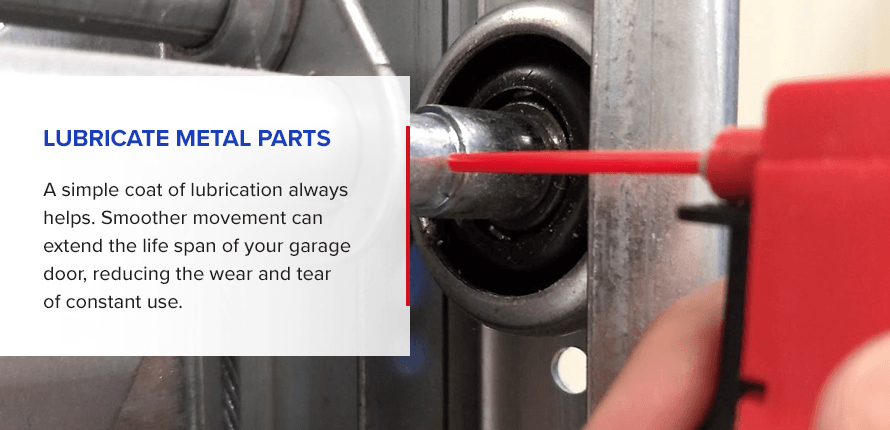
5. Lubricate Metal Parts
Spray lubricant on all your garage door’s moving metal parts, like springs, bearings and hinges. This is an easy do-it-yourself project that can make a huge difference. You can use standard engine oil, but avoid thick grease. If it’s too thick, it’ll make tracks stick and collect debris. When you apply the spray, work around plastic pieces. Afterward, wipe away excess lubricant to keep it from dripping on the floor.
A simple coat of lubrication always helps. Smoother movement can extend the life span of your garage door, reducing the wear and tear of constant use. While you should apply lubricant before winter, you can also apply it any time of year. To see if your garage door needs lubrication, watch as it opens or closes. See if it sticks or struggles at any point. If it does, apply lubricant.
6. Clear Sensors
As mentioned above, winter fog can inhibit your door’s safety sensors. These safety sensors are a vital element of your garage door. Garage doors are heavy and can cause severe injury if someone gets caught underneath. Photo eye sensors keep this from happening, stopping the door when there’s an obstacle.
If your door refuses to open or close, a blocked sensor may be the cause. Thankfully, this is easy to fix. Wipe the photo eye sensors so they can operate as they should. You’ll also want to clear away leaves, dirt, dust and snow from the lenses. Keep the area around the base of the door unobstructed, and shovel away snow and dirt.
7. Replace Old, Worn Springs
The metal hardware on your door needs to be strong when winter comes around. Worn metal components can compromise your door’s ability to function. Before winter, you might want to have a professional replace your springs. Grinding or squeaking sounds or stuttered movement might indicate an issue with your springs. First, carefully apply lubricant. If the issue persists, contact a professional service to replace the broken springs.
What to Do if Your Garage Door Is Not Working
Whether or not you’ve taken necessary precautions, emergencies can happen. In some situations, you need an immediate fix and waiting several days is not an option. For example, if your door is unable to close, everything in your garage is vulnerable to the elements. In a scenario like this, contact a 24/7 emergency repair service. An on-call technician will arrive to address the issue so you can continue your regular activities.
Contact American Overhead Doors for Garage Door Service and Repairs
When preparing your home or business for the harsh Connecticut winter, it’s important to remember the garage. Your garage has to withstand heavy use in all climates, rain or shine. At American Overhead Doors, we provide professional garage door service, repair and replacement for homes and businesses to prepare you for any season. Whether you’re looking for preventive maintenance, part replacement or emergency response, we can help. For all your garage door needs, contact American Overhead Doors today.

